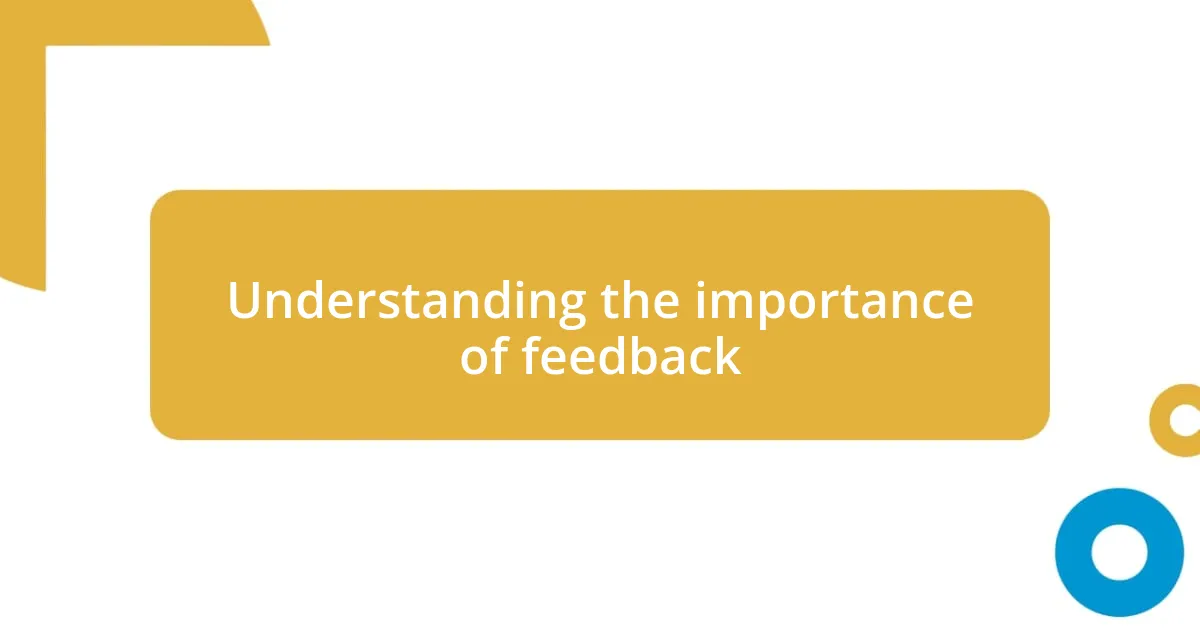Key takeaways:
- Feedback is essential for personal and professional growth, fostering trust and enhancing creativity in client relationships.
- Establishing effective communication channels, such as regular check-ins and utilizing various platforms, encourages open dialogue and timely feedback.
- Analyzing feedback involves recognizing recurring themes and approaching it with curiosity to deepen understanding and improve future collaboration.
- Responding to feedback professionally and implementing changes requires empathy, transparency, and flexibility, ultimately leading to stronger partnerships and project success.

Understanding the importance of feedback
Feedback is an essential tool for growth, both for individuals and businesses. I remember a specific project where my client provided insights that initially felt tough to hear. It was that constructive criticism that ultimately refined my work and deepened my relationship with the client. Isn’t it fascinating how feedback can turn a challenging moment into a major breakthrough?
Listening actively to feedback opens doors to improvement that we may not recognize on our own. I once encountered a situation where a client expressed dissatisfaction with a design choice. Instead of defending my decision, I paused and asked questions to understand their perspective better. Engaging in this dialogue not only clarified their vision but also transformed our collaboration into something much greater. Doesn’t it just feel rewarding when you realize that feedback can lead to enhanced creativity and satisfaction for everyone involved?
Understanding feedback helps build trust. Clients appreciate when they see that their opinions genuinely matter. I often find that after implementing suggestions, the clients’ overall confidence in my work grows, which in turn drives me to deliver even better results. What could be more motivating than knowing my efforts are aligned with the needs of those I serve?

Establishing effective communication channels
Establishing effective communication channels is crucial in fostering a solid feedback loop with clients. I’ve found that regular check-ins through various platforms can make a significant difference. For instance, I keep a dedicated communication space, like a project management tool or a messaging app, where clients can voice their thoughts anytime. It feels good knowing they have a direct line to me, and this openness helps in addressing concerns before they escalate.
Here are some strategies that work well for me:
- Utilize Multiple Platforms: I mix emails, phone calls, and chat applications. This variety ensures that there’s always a way for clients to reach out based on their preference.
- Set Regular Updates: Scheduling recurring meetings, even brief ones, gives clients a chance to share thoughts consistently.
- Encourage Open Dialogue: I’ve learned to invite feedback actively, letting clients know their insights are welcomed at any stage.
- Be Responsive: Timely replies show clients that their concerns are valued and taken seriously.
- Create a Feedback Framework: Having a structured way for clients to share their thoughts, like surveys or feedback forms, makes it easier for them to participate.
By implementing these channels, I create an inviting environment for clients to share their insights. It’s empowering for both parties and leads to a stronger partnership.

Techniques for gathering client feedback
When it comes to gathering client feedback, I’ve discovered that techniques tailored to my audience yield the best results. One method that resonates well is conducting short, focused surveys after a project milestone. I recall a design project where I sent a brief survey to gauge my client’s satisfaction. The responses were enlightening, helping me understand what worked and what could be improved. It’s remarkable how a simple questionnaire can uncover insights that drive future success.
I also appreciate the power of informal feedback sessions. Once, while having coffee with a client, I casually asked for their thoughts on my recent work. The conversation flowed naturally, and they opened up about ideas I hadn’t considered. This relaxed setting often allows clients to express their opinions more freely than in a formal meeting. Isn’t it interesting how sometimes, the best feedback happens outside of structured environments?
Furthermore, I’ve embraced collaborative tools that allow real-time comments on drafts or designs. I remember sharing a document via a collaborative platform and inviting my client to add notes directly. This interactive approach made them feel invested in the project, and their feedback was immediate and actionable. I love how technology can bridge the distance, making feedback a dynamic and continuous process.
| Technique | Description |
|---|---|
| Surveys | Structured questionnaires to assess satisfaction and gather insights. |
| Informal Feedback | Casual conversations that encourage clients to share thoughts freely. |
| Collaborative Tools | Platforms that allow clients to provide real-time feedback on work. |

Analyzing and interpreting feedback
When analyzing feedback, I always start by identifying the recurring themes. For example, during one project, multiple clients mentioned the clarity of communication as a highlight. That insight sparked an “Aha!” moment for me; it reinforced the importance of transparency. I realized that when clients feel informed, their trust grows, making it even easier to collaborate effectively.
Interpreting feedback can be a nuanced process. I remember a time when a client expressed dissatisfaction with a final product. Initially, I felt defensive, but I opted to dig deeper. What I discovered was that their expectations were rooted in a previous project that was significantly different. This taught me that context matters. It’s crucial to approach feedback with curiosity rather than judgment, allowing for a richer understanding of what the client truly needs. Have you ever experienced that shift from defensiveness to understanding? It can change everything.
Ultimately, it’s about balancing the quantitative and qualitative aspects of feedback. I often find myself pouring over survey results while also considering the emotions behind client comments. Just the other day, a client expressed frustration mixed with appreciation. This duality was a reminder that feedback isn’t just about the “what” but also the “how” and “why.” Recognizing those emotional layers not only improves my response but also strengthens the client relationship.

Responding to feedback professionally
Responding to client feedback professionally is essential in maintaining a strong relationship. I remember a situation where I received a less-than-favorable comment on a draft I submitted. Instead of taking it personally, I thanked the client for their honesty and asked for specific examples they had in mind. This not only diffused any potential tension but also opened up a constructive dialogue that allowed us to refine the project together. Isn’t it fascinating how a simple act of gratitude can turn a critique into an opportunity for collaboration?
When I respond to feedback, I strive to embody empathy and understanding. There was a time when a client expressed disappointment, feeling that my design didn’t reflect their initial vision. Rather than dismissing their feelings, I acknowledged their concerns and asked what elements specifically needed adjustments. It took some patience and active listening, but ultimately, this approach not only reassured the client but also deepened our partnership. Have you ever noticed that when you truly listen, the exchange can bridge gaps you didn’t even know existed?
Maintaining professionalism also means being transparent about what can and cannot be changed. Just last month, a client wanted a significant alteration to our project’s direction that, while valid, was unfeasible within the timeline we had set. Rather than rejecting their idea outright, I walked them through the implications and collaboratively explored alternative solutions. This transparent communication kept our rapport intact while ensuring we remained aligned on project goals. How often do we overlook the balance of honesty and professionalism when handling feedback? It’s a fine line, but when navigated well, it leads to stronger outcomes.

Implementing changes based on feedback
Implementing changes based on client feedback can be a transformative experience. I recall a project where several clients expressed concerns about the usability of a new feature I had developed. Taking their feedback to heart, I organized a feedback session where we could discuss their insights directly. Their contributions were invaluable; not only did we identify the issue, but their suggestions led to a complete redesign that enhanced the user experience. Isn’t it rewarding when a collaborative effort pushes a project beyond initial expectations?
Adjusting my approach based on feedback requires both flexibility and courage. For instance, a client once highlighted that my proposed timeline was overly ambitious given their internal processes. Initially, I was reluctant to extend the timeline, fearing it would affect deliverables. However, after reflecting on their points and our previous experiences working together, I recognized the need for compromise. This adjustment not only relieved their stress but also solidified our partnership. Have you ever adjusted your plans based on someone else’s insight and found that it made all the difference?
Ultimately, I believe that the real power of feedback lies in continuous improvement. After successfully integrating changes from client suggestions, I make it a point to follow up. I remember circling back to a client after implementing their recommendations on a project. They expressed appreciation for my responsiveness and invited me to apply similar changes in future projects. This mutual growth and ongoing dialogue create an environment where clients feel valued and invested. Isn’t it fascinating how ongoing improvement drives not just project success, but lasting relationships?














